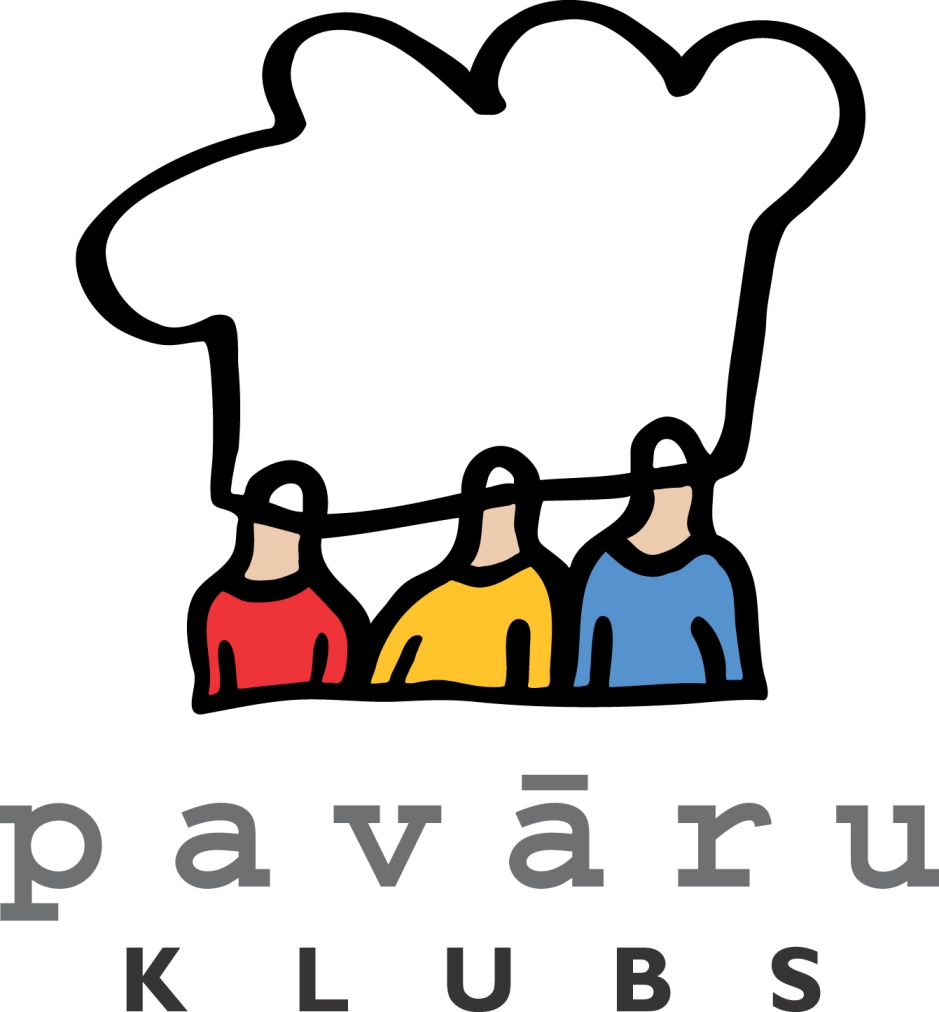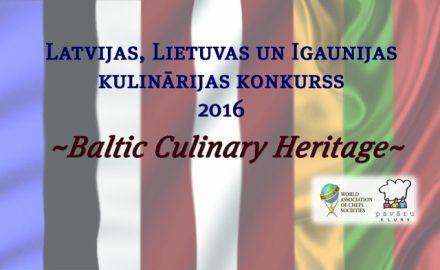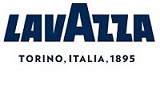JaunumiBALTIJAS VALSTU KULINĀRIJAS KONKURSS
Sen lolotais sapnis Baltijas valstīm par pašām savu kulinārijas konkursu beidzot ir piepildījis – jau šī gada rudenī tieši Rīgā pirmo reizi pulcēsies pavāru komandas no Latvijas, Lietuvas un Igaunijas, lai aktualizētu Baltijas valstu kulinārā mantojuma daudzveidību un sacenstos par pašu pirmo laureātu godu jaunajā konkursā "Baltic Culinary Heritage"!
Informācija par Latvijas komandu un tās gatavošanos konkursam sekos!


Culinary Competition of Baltic States
2016
~Baltic Culinary Heritage~
I GENERAL INFORMATION AND RULES
1. Date: 09.09.2016.
2. Time: 7:30 – 14:30
3. Organizing committee: Baltic Association of Chefs Societies
4. Contestants:
3 teams – each representing one of the Baltic states (Latvia, Lithuania, Estonia).
4.1. Each team is approved by chefs association of represented country.
4.2. Each team includes 4 participants:
- Chef. A chef with a minimum of 5 years experience overseeing a chef brigade; employed in the Baltic country he/she represents for a minimum of one year.
- Pastry chef. A pastry chef qualified professional with a minimum of 3 years of experience, or Chef in kitchen with a minimum of 5 years of experience, employed in the Baltic country he/she represents for a minimum of one year.
- Young chef. A young chef of age 23 or less.
- Manager. An English speaking manager is responsible for communication with organizers of the contest as well as for supporting the team and making sure that all rules and regulations are followed. The manager is not allowed to step in the competition box during the contest. The manager is allowed to help with setting up the composition, which is placed outside the competition box.
5. Competition tasks.
5.1. Each team will plan, prepare, cook and present a 3-course meal (starter – main course – dessert) for 30 persons within 5 hour from a basket of ingredients supplied by the organizers (main ingredients) and participants (extra ingredients).
5.2. Each team also has to prepare a composition "Baltic Culinary Heritage" which will include all three courses and will be judged by audience of the contest.
6. Entries.
Registration forms (see attachment 1) are sent by e-mailing at lv@chef.lv.
A closing date for entries is 15.08.2016.
7. Entry fees: 25.00 Eur * 3 CHEFS = 75.00 Eur
7.1. METHOD OF PAYMENT: Bank transfer. All payments to be subscribed to the following account:
Registration Number: LV 40008082630
Name of the Bank: AS Swedbank
Bank account: LV43HABA0551007700946
SWIFT code: HABALV22
7.2. Entrance fee will not be refunded if the competition is cancelled for reasons beyond the organizer’s control, or if competitors withdraw entries. This is to cover administration costs.
8. Organizer’s rights.
The organizer reserves the right to redefine, modify or add to any of the above rules and conditions and their interpretation of these is final.
9. Cancelation.
The organizer is entitled to cancel or postpone the salon, or alter the duration, timing or schedule of the event.
10. Responsibility for the loss or damage.
The organizer shall not under any circumstances be responsible for the loss or damage of any exhibit, goods, and dishes or personnel belongings. However, reasonable precautions will be taken to avoid loss or damage.
11. Judge.
The competition will have two Juries: The Official Jury (5 members) and The Technical Jury (3 members).
11.2. The five members of the official Jury are well known professionals in gastronomic arts from Western Europe and Northern countries.
11.3. The technical jury will be provided from three Baltic states – one member from each country.
11.4. The mark score attributed by each Member of the Jury is personal and the total score will be calculated by the Chief Judge. Panel of Judges Decision is Final and binding.
12. Judging.
All perishable exhibits will be judged on the day of entry. Competitors are to refrain from talking to the judges during and prior to the event.
13. Awards & Certificates.
13.1. Each participant will receive a certificate of participation.
13.2. The Jury will evaluate winners in two categories: "The Best Team of the Baltic states" and "The Best Young Chef of the Baltic states".
13.3. All teams will receive award certificates and medals. The winning team will receive "Baltic Culinary Heritage" competition symbol as traveling prize an individual trophies.
13.4. The winning Young chef might not be chosen from the winning team and will be awarded separately.
II Competition rules
14. COMPETITION IN GENERAL.
Each team is given 3 hours for cooking and presenting starter, 4 hours for cooking and presenting main course and 5 hours for cooking and presenting dessert. See Picture 1 for the timing schedule.

15. MENU.
The menu must be handed to the judges (neatly written in English) not later than 10 minutes before the start of the competition.
16. COMPOSITION.
16.1. Theme of the composition: Baltic Culinary Heritage.
16.2. Home task for the competition: prepare and present of the day of the competition a composition where all three courses will be presented when ready.
16.3. Technical regulations: the composition shall not be higher, than 1 meter from the surface it is placed on.
17. STARTER.
17.1. Main ingredient for the starter is whole pike-perch (Zander / Stizostedion lucioperca), which is provided by the organizers.
17.2. The pike-perch is cooked in two different techniques chosen freely by the contestants.
17.3. The team is preparing 30 portions of the starter.
17.4. Weight of one portion is 120 grams.
17.5. One of the portions is placed in the composition the team has prepared.
18. MAIN COURSE
18.1. Main ingredients for the main course is whole rabbit, two vegetables by choice and one ingredient containing starch. The rabbit is provided by the organizers.
18.2. The team is preparing 30 portions of the main course.
18.3. Weight of one portion is 240 grams.
18.4. One of the portions is placed in the composition the team has prepared.
19. DESSERT.
19.1. Main ingredients for the dessert is sea-buckthorn (Hippophae rhamnoides) and biscuit dough. The sea-buckthorn and ingredients for the dough is provided by the organizers.
19.2. The team is preparing 30 portions of the main course.
19.3. Weight of one portion is 110 grams.
19.4. One of the portions is placed in the composition the team has prepared.
20. Technical support.
20.1. The organizers and "Electrolux" provides following support for each competition box:
A) Tables for cooking and serving;
B) Fridge x 2 (from +2° to +4 °C);
C) 4-burner Gas Stove x 2;
D) Multi Function / Convection Oven;
E) 8 trays;
F). Freezer (one for all teams);
G). Sink with hot and cold water;
H) 220V electrical outlets x 4;
J) Paper towels, disposable gloves, detergents and garbage bins;
K) Medical first aid kit.
20.2. During the competition participants may use their knives, electrical equipment and small kitchen equipment with total capacity is no more than 10 kW.
III HYGIENE & FOOD SAFETY GUIDELINES
21. DRESS STANDARDS.
21.1. Chef’s jacket – the chef or team should enter the competition arena wearing a clean white chef’s jacket that has been pressed.
21.2. Chef’s hat – normal chef’s hat is required, baseball cap style will not be accepted.
21.3. Apron – apron length can be determined by the team, and butcher stripe apron can be used, teams must change aprons prior to service.
21.4. Shoes – a safety style shoe that is non-slip is to be worn.
21.5. Neckties – are optional.
21.6. No visible jewelry is to be worn except for a wedding band, ear stud or sleeper.
22. PERSONAL HYGIENE
22.1. Male chefs should be clean shaven.
22.2. Chefs with beards must wear a beard net.
22.3. Sleeves of chef’s jackets must not be rolled up past the elbow.
22.4. Chefs should be clean and showered with good personal hygiene.
22.5. After shave and perfumes must not be over powering.
23. FOOD & DRINK DURING COMPETITION
23.1. Industrially bottled and packaged beverages can be consumed in the competition kitchen.
23.2. Industrially produced and packaged nutrition, like energy bars or gels, can be consumed in the competition kitchen.
23.3. Prepared and cooked foods, like sandwiches or salads, can only be consumed during breaks and outside the kitchen.
24. FOOD HANDLING REQUIREMENTS
24.1. Basic principles of Hazard Analysis Critical Control Points (HACCP) adopted for restaurants, must be adhered to.
24.2. Temperature recording of perishable food items must be recorded when leaving preparation kitchen.
24.3. Temperature recording of perishable food items must be recorded when entering competition kitchen.
24.4. Food items to be stored correctly between – 180 C to +40C
24.5. Chefs and teams must wash their hands prior to starting in a competition.
24.6. Chefs and teams must wash their hands when they change tasks.
24.7. Chefs must wash their hands on return to kitchen if they are required to leave the competition kitchen for any reason.
24.8. Food items should be held at 650 C for no longer than 2 hours.
24.9. Tasting of food must be carried out with disposable single use utensils or utensils hat are washed after each tasting.
24.10. Double dipping into sauces or food items with the same spoon is not acceptable.
24.11. Food items in transport and stored must be covered with clear plastic or a lid.
24.12. Gloves can be worn if working with dirty items or items that stain, for example beetroot, etc.
24.13. Ready To Eat food (RTE) that is not at 650 C should not be handled with bare hands. Should be from a plate, tongs, chop sticks, tweezers or with hands covered with gloves.
24.14. Gloves do not give an automatic exemption to proper food handling techniques. Once you change the food item, you must change your gloves.
24.15. Basic spills should be cleaned up immediately.
24.16. Ensure that knives are kept clean at all times.
25. STORAGE OF FOOD ITEMS
25.1. Food items should be on trays or in containers and covered.
25.2. When setting up your chiller/refrigeration, ensure items do not drip on items stored below.
25.3. Food trimmings from your mise en place should be kept separate and not mixed together if they are to be used later.
25.4. Food trimmings should be identified and labeled as well as covered to avoid cross – contamination.
25.5. Do not store raw food with cooked food items.
26. SANITATATION
26.1. Hands to be washed frequently.
26.2. Hand paper towels to be used for bench wiping and hands.
26.3. Cloth towels only to be used for hot items.
26.4. Benches should be sanitized prior to commencing the competition, after each task is completed and at the end of the competition.
26.5. Cutting boards in PEHD material are preferred and should be clean and have the appropriate color used for each task. The basic color usage is; green for vegetable, red for meat, blue for fish and brown for cook meats. Otherwise, white is acceptable a s a neutral colour for all tasks, cutting boards should not be made of wood.
26.6. Work areas should always be clear of unnecessary items.
These guidelines are an overview of critical points that must be adhered to, breaching hygiene can reflect badly on our professionalism as most competitions are under the watchful eye of the public and media.
To download the statutes – press here
















